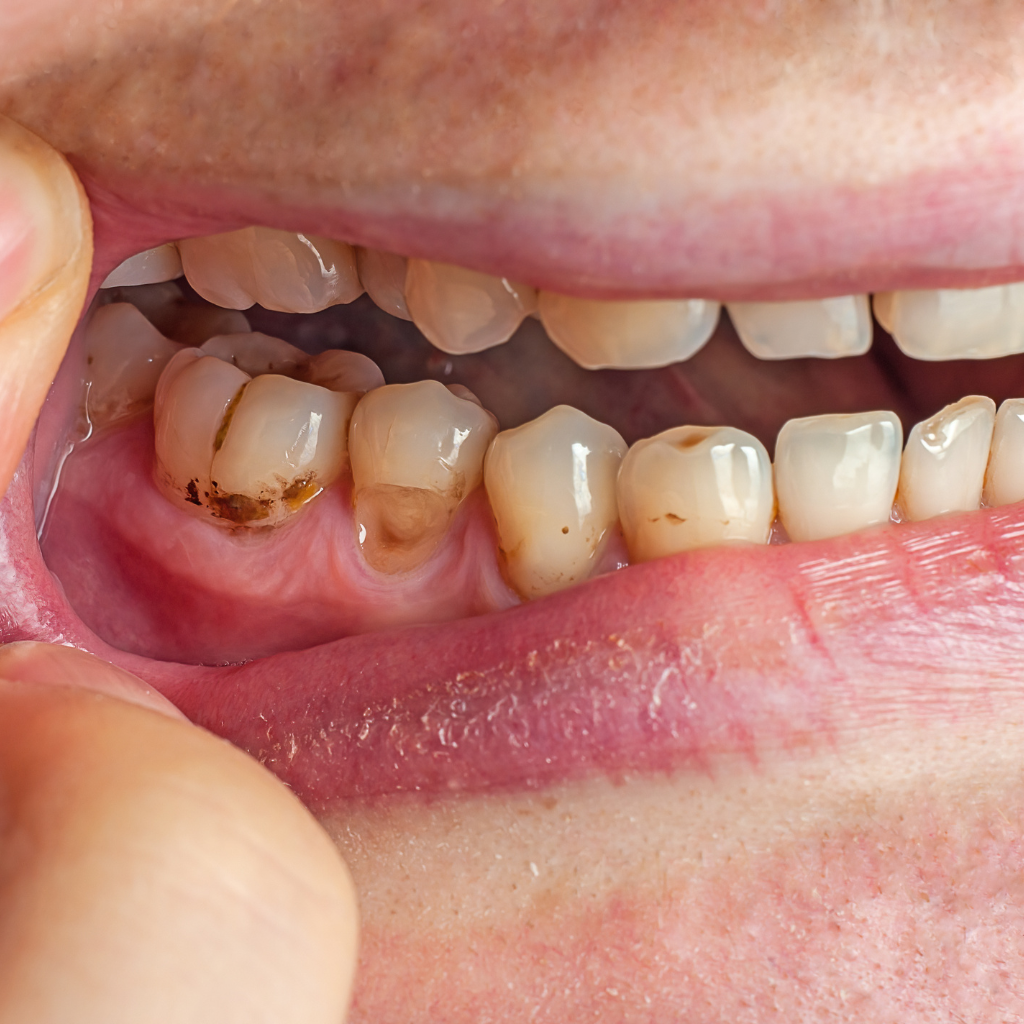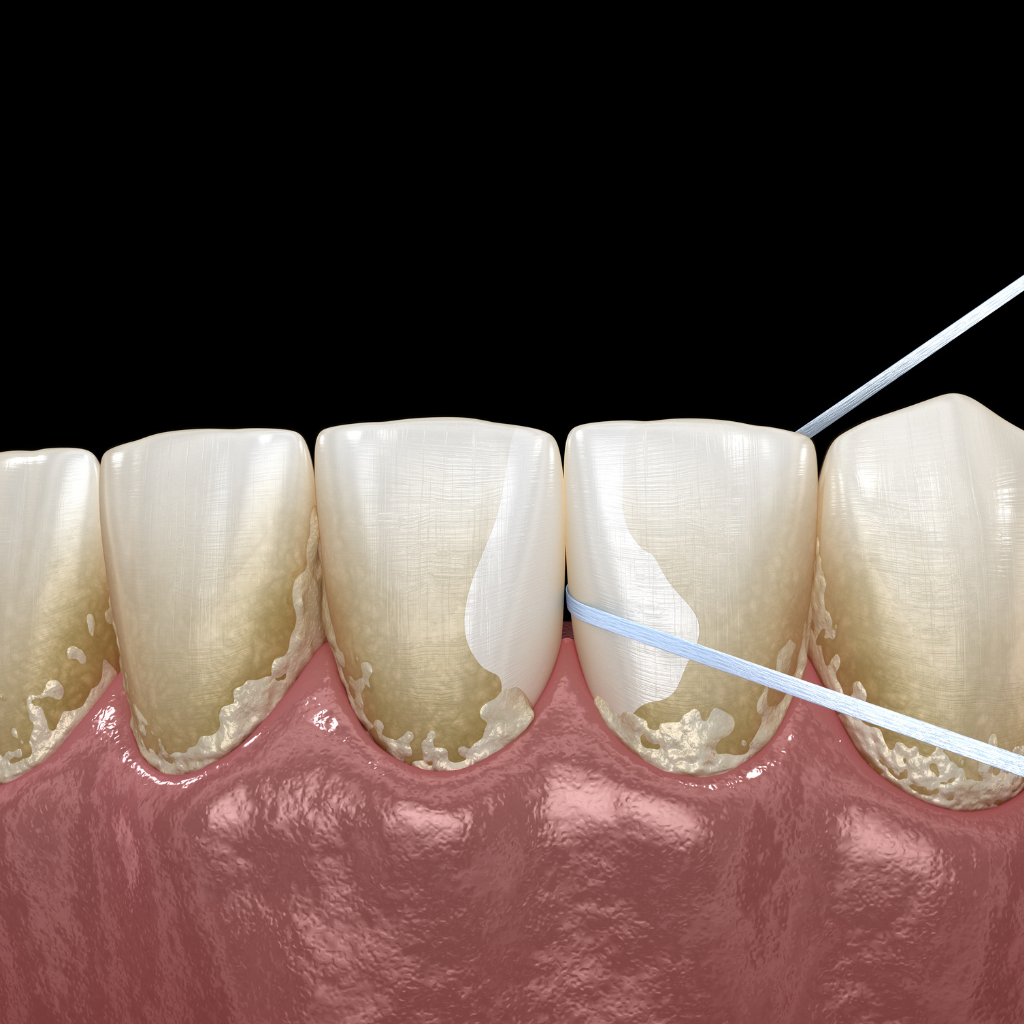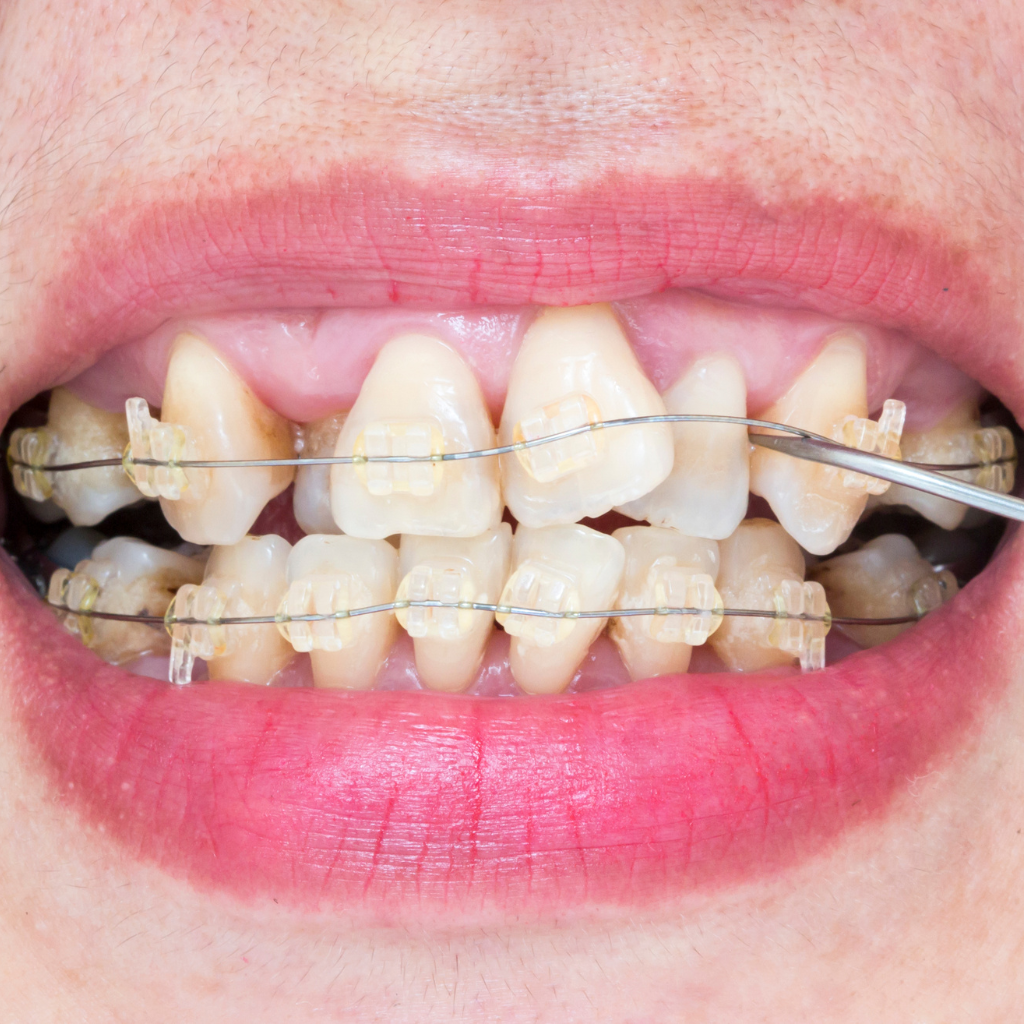Plaque removal is essential for oral health. Consistent brushing with fluoride toothpaste and flossing are effective daily practices to disrupt plaque formation. Using a soft-bristled toothbrush and an 18-inch piece of floss guarantees thorough cleaning. Implementing antibacterial mouthwash can further reduce bacteria. Natural remedies like baking soda and coconut oil are beneficial additions to the oral care routine. Professional cleaning may be necessary for persistent issues. There’s more to discover about maintaining dental hygiene effectively.
Key Takeaways
- Brush teeth twice daily using fluoride toothpaste and a soft-bristled brush to effectively remove plaque from teeth.
- Floss daily to clean areas between teeth that brushing can’t reach, preventing plaque buildup.
- Use antibacterial mouthwash to reduce bacteria and prevent plaque formation.
- Limit sugary and starchy foods to decrease substrates for bacterial growth that lead to plaque.
- Schedule regular dental check-ups for professional cleanings and monitoring of plaque and tartar levels.
What Causes Plaque and How Can It Be Prevented?
Plaque forms on teeth due to the accumulation of bacteria, saliva, and food particles, creating a sticky biofilm.
Effective prevention strategies include regular brushing and flossing, which disrupt the plaque formation process, as well as routine dental check-ups.
Additionally, a diet low in sugars and starches can greatly reduce the risk of plaque development by limiting the substrates available for bacterial growth.
Understanding the Formation of Plaque on Teeth
When dental hygiene is neglected, a sticky, colorless film of bacteria known as plaque begins to accumulate on the surfaces of teeth.
This dental plaque is primarily composed of bacteria, which thrive on the sugars and food particles left in the mouth. As plaque accumulates, it forms on your teeth, creating an environment conducive to further bacterial growth.
The bacteria in plaque metabolize these food particles, producing acids that can erode tooth enamel. This plaque buildup, if left unchecked, hardens into tartar, making it more difficult to remove.
The buildup of plaque on your teeth can lead to various dental issues, including cavities and gum disease. Understanding the formation of plaque is essential for implementing effective oral hygiene practices.

Strategies to Prevent Plaque Buildup and Maintain Oral Health
To mitigate the detrimental effects of plaque accumulation, adopting effective strategies for prevention is critical. Regular oral hygiene practices are paramount. Individuals should brush their teeth twice daily with fluoride toothpaste to effectively remove plaque from teeth and prevent plaque buildup. Additionally, flossing daily aids in eliminating dental plaque on teeth, particularly in areas that brushing may miss. Consistent care of your teeth and gums helps in reducing the risk of plaque and tartar formation. Professional dental visits are essential; dentists can provide cleanings and guidance for keeping teeth healthy.
| Strategy | Frequency | Benefit |
|---|---|---|
| Brush your teeth twice | Daily | Reduces dental plaque on teeth |
| Floss your teeth | Daily | Cleans between teeth and gums |
| Visit your dentist | Biannually | Monitors plaque and tartar |
These measures collectively maintain peak oral health.
Role of Diet in Preventing Plaque from Forming
Although often overlooked, diet plays a fundamental role in the formation and prevention of dental plaque. Consuming a balanced diet can prevent plaque from forming by reducing the availability of sugars and carbohydrates, which are primary contributors to plaque and tartar development.
Foods rich in calcium and phosphorus help in keeping teeth healthy and strong, thereby minimizing the growth of plaque. Maintaining a diet low in sugary and acidic foods is essential to prevent plaque buildup and guarantee good care of your teeth.
Additionally, incorporating fibrous foods can aid in naturally cleaning the teeth and gums, further reducing plaque accumulation. Ultimately, taking good care of your teeth requires attention to dietary choices to effectively manage and prevent plaque formation.
Effective Ways to Remove Plaque on Your Teeth
Maintaining effective daily oral hygiene habits is essential for the removal of plaque. Regular brushing, at least twice daily, disrupts plaque formation and reduces the risk of dental issues.
Complementing this with proper flossing techniques guarantees the removal of plaque from areas that are difficult to reach with a toothbrush alone.
Daily Habits that Help Remove Plaque
A few essential daily habits can greatly aid in the effective removal of dental plaque, a sticky film of bacteria that forms on teeth.
To remove plaque, it is vital to brush your teeth twice a day, utilizing a toothbrush with soft bristles and fluoride toothpaste. This practice effectively targets plaque buildup, maintaining teeth healthy and strong.
Additionally, flossing your teeth at least once daily reaches areas that a toothbrush cannot, markedly enhancing plaque removal. These actions are instrumental in minimizing dental plaque on your teeth.
Furthermore, incorporating an antibacterial mouthwash can further help remove plaque by reducing bacterial accumulation.
Consistent adherence to these daily oral hygiene practices guarantees peak plaque removal and contributes to long-term dental health.
The Importance of Brushing Your Teeth at Least Twice a Day
Consistent oral hygiene practices greatly impact the effective removal of dental plaque. To maintain ideal oral health, it is essential to brush your teeth at least twice daily. This routine helps clean your teeth and effectively remove plaque.
Brushing in the morning and before bed prevents the accumulation of plaque on teeth, reducing the risk of plaque and tartar buildup. The mechanical action of brushing and flossing your teeth assists in the dislodgment and removal of food particles and bacteria that contribute to plaque buildup.
How to Floss Your Teeth for Optimal Plaque Removal
Flossing plays an essential role in the ideal removal of plaque from areas that a toothbrush cannot reach. An effective flossing technique is vital for best plaque removal and maintaining dental health.
- Select the Right Floss: Choose a dental floss that suits individual needs, whether waxed, unwaxed, or dental tape, to effectively remove plaque from teeth and prevent plaque buildup.
- Proper Flossing Technique: Utilize an 18-inch piece of floss, wrapping it around the fingers, and gently sliding it between teeth. Curve the floss around each tooth, moving up and down for thorough cleaning.
- Consistency in Dental Care: Floss your teeth at least once daily to disrupt plaque formation and support overall dental care.
Regular flossing complements brushing, ensuring all-encompassing plaque removal and healthier teeth.

How to Get Rid of Plaque with Home Remedies
Removing plaque at home can be effectively managed using specific natural ingredients known for their ability to reduce plaque accumulation.
Common DIY remedies include the use of baking soda, which neutralizes acids in the mouth, and oil pulling with coconut oil, which may reduce harmful bacteria.
Regular application of these methods, alongside proper oral hygiene practices, can greatly aid in maintaining dental health.
Natural Ingredients that Help Reduce Plaque Accumulation
A variety of natural ingredients have been shown to effectively reduce plaque accumulation on teeth through their antibacterial and abrasive properties.
Plaque is a biofilm that forms on teeth, contributing to plaque buildup. Utilizing natural ingredients can help reduce plaque, remove plaque, and prevent plaque.
- Baking Soda: Known for its mild abrasiveness, baking soda is a natural ingredient that can efficiently remove plaque from your teeth. It neutralizes acids in the mouth, thereby minimizing plaque formation.
- Coconut Oil: Coconut oil contains lauric acid, which has antibacterial properties that help reduce plaque and keep away plaque-related issues.
- Green Tea: Rich in catechins, green tea is a natural ingredient that inhibits bacterial growth, making it one of the best ways to remove plaque through home remedies.
DIY Home Remedies for Removing Plaque
Building on the effectiveness of natural ingredients, various DIY home remedies can be employed to remove plaque from teeth.
Utilizing baking soda as a primary agent is popular because it has been proven to help remove plaque on teeth effectively. Mixing baking soda with water creates a paste that can be applied with a toothbrush to remove plaque at home. Studies suggest that baking soda removes more plaque than non-baking soda toothpaste.
Additionally, using toothpaste containing baking soda is vital to remove plaque and prevent plaque and tartar buildup. Regular use of these methods can considerably aid in removing plaque and tartar, as plaque can build up over time.
Implementing these strategies is essential for maintaining oral health and preventing dental issues.
Understanding the Difference Between Plaque and Tartar
Plaque is a soft, sticky film of bacteria that forms on teeth and can harden into tartar when not removed.
Tartar, also known as calculus, adheres strongly to teeth and can only be removed by dental professionals.
Ignoring the buildup of plaque and tartar can lead to gum disease, cavities, and other oral health issues, making regular removal essential for maintaining dental health.
What Happens When Plaque Hardens into Tartar?
When oral hygiene is neglected, the accumulation of bacterial plaque on teeth can lead to the formation of tartar, a hardened deposit that adheres strongly to the tooth surface.
This hardened plaque, also known as tartar, is difficult to remove with regular brushing and flossing. It can cause significant oral health issues:
- Tartar Buildup: As tartar accumulates, it creates a rough surface on your teeth, making it easier for more plaque to adhere and grow.
- Damage to Teeth and Gums: Tartar can lead to cavities and irritate gums, potentially causing gingivitis, a precursor to periodontal disease.
- Professional Removal: Only a dentist can effectively remove tartar, preventing further damage to teeth and gums.
Understanding the differences between plaque and tartar is essential for maintaining oral health.
Risks of Ignoring Plaque and Tartar Buildup on Your Teeth
Why is it vital to address plaque and tartar buildup promptly? Plaque, a sticky film of bacteria, continuously accumulates on your teeth.
If plaque is not removed, it can harden into tartar, a calcified deposit that firmly adheres to the tooth surface. This buildup can be detrimental, potentially damaging your teeth and gums.
Tartar on your teeth provides an ideal environment for further bacterial growth, exacerbating dental issues. Ignoring such buildup increases the risk of gingivitis, periodontal disease, and tooth decay.
Once tartar forms, it cannot be removed by regular brushing and requires professional dental intervention.
As a result, maintaining oral hygiene and removing plaque regularly is vital to preventing these adverse outcomes and preserving dental health.
Why Tartar Removal is Essential for Dental Health
Addressing plaque and tartar buildup is a fundamental aspect of maintaining dental health.
Plaque is a sticky film that forms on teeth due to bacteria and food debris, which can harden into tartar if not removed promptly. Tartar removal is essential because it can lead to gum disease and tooth decay.
Understanding the difference between plaque and tartar is vital for effective oral hygiene. To prevent and remove plaque, individuals should:
- Brush teeth at least twice daily to help get rid of plaque and prevent tartar from forming.
- Use dental floss to remove the plaque and food particles that build up on your teeth, especially in hard-to-reach areas.
- Schedule regular dental cleanings as the best way to remove tartar and maintain oral health.
When to Visit Your Dentist for Professional Plaque Removal
Regular dental check-ups are essential when addressing the accumulation of plaque and tartar, as these can lead to more serious oral health issues if not professionally managed.
Indications for scheduling a professional cleaning include persistent bad breath, gum inflammation, and visible tartar buildup.
During a tartar removal procedure, the dentist will employ specialized tools to meticulously eliminate hardened deposits, ensuring thorough cleaning and minimizing the risk of gum disease.

Signs It’s Time for a Professional Dental Cleaning
Recognizing specific indicators is essential. Significant plaque buildup, especially when brushing teeth for two minutes fails to get rid of plaque, suggests the need for professional intervention.
Here are some signs to observe:
- Yellow Discoloration: If teeth appear yellow due to plaque and food debris despite regular cleaning, professional dental cleaning may help remove the plaque effectively.
- Persistent Gingivitis: Continued inflammation of the gums signals ineffective plaque control. Professional cleaning assists in reducing plaque and gingivitis.
- Hard Deposits: Detection of hard, calcified deposits that resist brushing indicates the necessity for professional cleaning. Dental experts more effectively address these deposits than brushing teeth using standard methods.
These signs should prompt a dental consultation.
What to Expect During a Tartar Removal Procedure
A thorough understanding of the tartar removal procedure is essential for those considering professional plaque removal. During the procedure, a dental professional utilizes specialized tools to help remove hardened tartar that regular brushing cannot address. This method is a definitive way to remove plaque effectively.
People who brush their teeth diligently with toothpaste and incorporate rinsing in reducing plaque may still require periodic professional intervention. The process involves scaling and polishing to guarantee ideal oral health. Scaling targets the stubborn deposits that brushing alone cannot dislodge. Following this, polishing smoothens the teeth’s surface, reducing future plaque adherence.
Individuals seeking to maintain their teeth with this guide benefit from regular dental visits, complementing their daily oral hygiene routine.
Conclusion
In summary, maintaining ideal oral hygiene is essential in preventing and managing plaque buildup. Understanding the causes and implementing preventative measures, such as regular brushing and flossing, can greatly reduce plaque formation. Home remedies can complement these efforts, yet recognizing the distinction between plaque and tartar underscores the importance of professional dental care. Regular dental visits for professional cleaning are vital to address stubborn plaque and prevent progression to tartar, ensuring long-term dental health and preventing complications.


